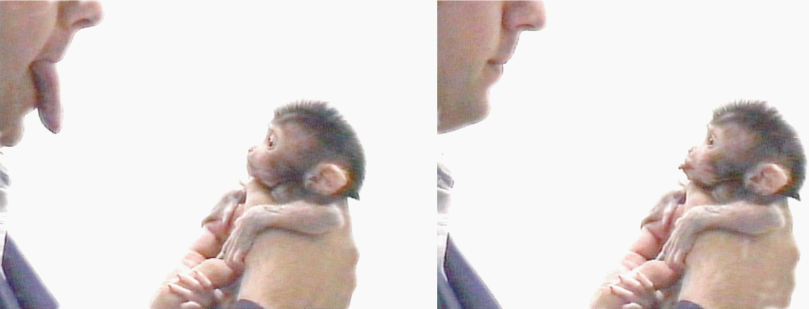In this post, “mirror neurons” – a hugely influential but controversial discovery.
Here is a picture of my brain in all its squishy, creepy glory…

People often use the phrase “getting inside someone’s head” for understanding them. Do you feel like you know me better from seeing inside my head? Have you learned anything from looking at my brain?
Unless you’re a neuroscientist, probably not (and if you are a neuroscientist I hope what you’ve learned is good news for me!). But if we were interacting face to face and you could only see the outside of my head, you’d probably learn quite a lot about me.
It’s easy to take for granted quite how good we are at recognising what other people are thinking or feeling because we probably pay more attention to times we’ve got it wrong (e.g. someone has lied to us) or found it difficult (you just cannot work out why that person seems angry at you!). If you saw me reaching over to my glass of water and picking it up, you’d know I was thirsty or at least wanted to take a drink.
This might seem obvious but something being obvious is probably a sign our brains are very good at it or used to doing it. If I asked you how you know I want a drink when I pick up a glass, you might answer that when you’re thirsty you pick up a glass of water, so you’re applying the same logic to my actions. According to an influential theory in social neuroscience, this is actually how the brain works at the level of individual neurons.
Like penicillin, radioactivity and Viagra, “mirror neurons” were actually discovered by accident. An Italian neuroscience lab were running experiments measuring activity from individual neurons in monkey’s brains. This requires inserting very thin electrodes into the brain which measure the neuron “firing”, conducting electrical pulses. The aim of the experiment was to learn more about how these neurons determined the hand movements of the monkeys as they picked up pieces of food.

As part of running the experiment, the human researchers were also picking up the pieces of food. Remarkably, they noticed that some neurons which fired when the monkey picked up the food, also fired when they observed the experimenter doing the same action. Like all good accidental discoveries, the team realised this was something meaningful and exciting and went on to do further tests. These showed the neurons were “mirroring” the actions of the person they were watching, as if the monkey itself was doing the action.
This theory could explain that overwhelming urge to yawn you often get when watching someone else yawn because seeing their yawn activates the same part of your brain which controls your yawning. Another classic example is the sense of feeling pain yourself when seeing someone else get hurt. Using neuroimaging, it has been shown that the same parts of the brain are active when we experience pain or imagine ourselves in pain as is activated by viewing someone else in pain. There is also evidence from fMRI research that areas of the human brain equivalent to those identified in the monkeys respond when we imitate others’ actions.

Obviously, these findings have led to some researchers claiming mirror neurons are integral to empathy and understanding others. There is also arguably some evidence the “mirror system” is disrupted in disorders of understanding others such as autism. However, this theory is far from accepted and many researchers strongly disagree. As always, some of the disagreement is around definitions and the concept of overlap between experiences I have and experiences you have in the brain is more widely accepted than some of the specific details of mirror neurons.
I think one reason the theory appeals is because it makes sense from an efficiency point of view. There are many ways in which the brain takes shortcuts to save processing time and the physical space different functions take up. Very early in evolution, the brain developed circuits to control our own actions so why develop whole separate circuits to understand the same actions of others?
Imagine you own a factory which produces white bread and you start needing to also make brown bread at different times. Would you build a whole other factory? You’d probably use the same equipment with different ingredients going in and different packaging when the bread comes out so you can tell which is which. This simplistic analogy not only demonstrates the need for efficiency, but also the crucial role of connectivity and information flow in the brain. If the whole procedure, ingredients, baking process and packaging, was the same the loaves would be indistinguishable.
In the same way, our brains have ways of telling my actions are my own and your actions are separate and, as a key criticism of the mirror neuron theory argues, a single neuron alone couldn’t do this. Obviously, the neural input (ingredients) are different, I feel my own movements or pain internally but get information about your movements or pain through vision or hearing. However, if we simply differentiated between ourselves and others, this would suggest we would have an equal understanding of, and empathy for all other people.
Clearly, this is not the case as factors such as how similar or close we are to the person and how we observe or hear of their situation influence how much we can put ourselves in their shoes. Future posts will consider some of these ways in which our understanding and empathy can be biased.
[…] kind is likely to make someone smile and if you see that smile for yourself, it might be catchy. A key theory about how we understand other people in neuroscience suggests that seeing someone else show an […]
LikeLike
[…] kind is likely to make someone smile and if you see that smile for yourself, it might be catchy. A key theory about how we understand other people in neuroscience suggests that seeing someone else show an […]
LikeLike
[…] kind is likely to make someone smile and if you see that smile for yourself, it might be catchy. A key theory about how we understand other people in neuroscience suggests that seeing someone else show an […]
LikeLike
[…] kind is likely to make someone smile and if you see that smile for yourself, it might be catchy. A key theory about how we understand other people in neuroscience suggests that seeing someone else show an […]
LikeLike
[…] kind is likely to make someone smile and if you see that smile for yourself, it might be catchy. A key theory about how we understand other people in neuroscience suggests that seeing someone else show an […]
LikeLike
[…] key theory about how we understand other people in neuroscience suggests that seeing someone else show an […]
LikeLike
[…] key theory about how we understand other people in neuroscience suggests that seeing someone else show an […]
LikeLike
[…] key theory about how we understand other people in neuroscience suggests that seeing someone else show an […]
LikeLike
[…] key theory about how we understand other people in neuroscience suggests that seeing someone else show an […]
LikeLike
[…] key theory about how we understand other people in neuroscience suggests that seeing someone else show an […]
LikeLike
[…] key theory about how we understand other people in neuroscience suggests that seeing someone else show an […]
LikeLike
[…] key theory about how we understand other people in neuroscience suggests that seeing someone else show an […]
LikeLike
[…] key theory about how we understand other people in neuroscience suggests that seeing someone else show an […]
LikeLike
[…] key theory about how we understand other people in neuroscience suggests that seeing someone else show an […]
LikeLike
[…] key theory about how we understand other people in neuroscience suggests that seeing someone else show an […]
LikeLike
[…] key theory about how we understand other people in neuroscience suggests that seeing someone else show an […]
LikeLike
[…] key theory about how we understand other people in neuroscience suggests that seeing someone else show an […]
LikeLike
[…] key theory about how we understand other people in neuroscience suggests that seeing someone else show an […]
LikeLike
[…] key theory about how we understand other people in neuroscience suggests that seeing someone else show an […]
LikeLike
[…] key theory about how we understand other people in neuroscience suggests that seeing someone else show an […]
LikeLike
[…] A key theory about how we understand other people in neuroscience suggests that seeing someone else show an emotion automatically activates the same areas of the brain as if we experienced that emotion for ourselves. […]
LikeLike
[…] kind is likely to make someone smile and if you see that smile for yourself, it might be catchy. A key theory about how we understand other people in neuroscience suggests that seeing someone else show an […]
LikeLike
[…] and most simply, a key theory in neuroscience says that witnessing someone else show an emotion automatically activates the same […]
LikeLike
[…] kind is likely to make someone smile and if you see that smile for yourself, it might be catchy. A key theory about how we understand other people in neuroscience suggests that seeing someone else show an […]
LikeLike
[…] kind is likely to make someone smile and if you see that smile for yourself, it might be catchy. A key theory about how we understand other people in neuroscience suggests that seeing someone else show an […]
LikeLike
[…] A key theory in neuroscience says that when we see someone else experience a positive emotion, the same part if our own brain lights up, giving us the same positive impact. […]
LikeLike
[…] kind is likely to make someone smile and if you see that smile for yourself, it might be catchy. A key theory about how we understand other people in neuroscience suggests that seeing someone else show an […]
LikeLike
[…] kind is likely to make someone smile and if you see that smile for yourself, it might be catchy. A key theory about how we understand other people in neuroscience suggests that seeing someone else show an […]
LikeLike
[…] kind is likely to make someone smile and if you see that smile for yourself, it might be catchy. A key theory about how we understand other people in neuroscience suggests that seeing someone else show an […]
LikeLike
[…] kind is likely to make someone smile and if you see that smile for yourself, it might be catchy. A key theory about how we understand other people in neuroscience suggests that seeing someone else show an […]
LikeLike